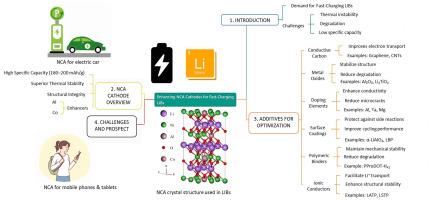快充锂离子电池:添加剂增强锂镍钴铝氧化物阴极的研究进展
IF 4.6
3区 工程技术
Q2 ENGINEERING, ELECTRICAL & ELECTRONIC
引用次数: 0
摘要
由于对电动汽车和便携式电子产品的依赖日益增加,对高效、快速充电的锂离子电池(lib)的需求正在增加。然而,传统的锂离子电池存在热不稳定性、快速降解和快速充电时比容量低等局限性,限制了其性能和使用寿命。人们正在探索先进的材料和创新的修改来克服这些挑战,增强lib的能力。其中,锂镍钴铝氧化物(LiNi0.8Co0.1Al0.1O2, NCA)阴极由于其高比容量(180-200 mAh/g)和优异的热稳定性而成为有希望的候选材料。本文通过探索各种添加剂和方法,包括导电碳、金属氧化物、掺杂元素、表面涂层、聚合物粘合剂和离子导体,重点对用于快速充电的NCA阴极进行了优化。在合成过程中使用诸如与活性物质混合、表面涂层和掺杂等策略来应用这些添加剂。分析了这些修改对NCA阴极电极性能指标的影响,重点是优化快速充电能力。这篇综述强调了NCA阴极电极在减少充电时间和延长循环寿命方面的潜力,同时解决了与材料成分和环境影响相关的挑战。展望了未来的研究前景,以提高NCA阴极电极在电动汽车和便携式电子设备中的适用性,并解决相关的制造挑战。本文章由计算机程序翻译,如有差异,请以英文原文为准。

Fast–charging lithium–ion batteries: Review on enhancing lithium nickel cobalt aluminum oxide cathodes with additives
The demand for efficient, fast–charging lithium–ion batteries (LIBs) is increasing due to the growing reliance on electric vehicles and portable electronics. However, traditional LIBs have several limitations including thermal instability, rapid degradation, and low specific capacity during fast–charging, which restrict their performance and longevity. Advanced materials and innovative modifications are being explored to overcome these challenges and enhance the capabilities of LIBs. Among these, lithium nickel cobalt aluminum oxide (LiNi0.8Co0.1Al0.1O2, NCA) cathodes have emerged as promising candidates due to their high specific capacity (180–200 mAh/g) and superior thermal stability. This review focuses on the optimization of NCA cathodes for fast–charging applications by exploring various additives and methodologies involving conductive carbon, metal oxides, doping elements, surface coatings, polymeric binders, and ionic conductors. These additives are applied using strategies such as mixing with the active material, surface coating, and doping during the synthesis. The impact of these modifications on the performance metrics of the NCA cathode electrode is analyzed, emphasizing optimizing fast–charging capabilities. This review highlights the potential of NCA cathode electrodes to reduce charging times and extend cycle life, while addressing challenges related to material composition and environmental impact. Prospects for future research are discussed to enhance the applicability of NCA cathode electrodes in electric vehicles and portable electronic devices, and to address associated manufacturing challenges.
求助全文
通过发布文献求助,成功后即可免费获取论文全文。
去求助
来源期刊

Materials Science in Semiconductor Processing
工程技术-材料科学:综合
CiteScore
8.00
自引率
4.90%
发文量
780
审稿时长
42 days
期刊介绍:
Materials Science in Semiconductor Processing provides a unique forum for the discussion of novel processing, applications and theoretical studies of functional materials and devices for (opto)electronics, sensors, detectors, biotechnology and green energy.
Each issue will aim to provide a snapshot of current insights, new achievements, breakthroughs and future trends in such diverse fields as microelectronics, energy conversion and storage, communications, biotechnology, (photo)catalysis, nano- and thin-film technology, hybrid and composite materials, chemical processing, vapor-phase deposition, device fabrication, and modelling, which are the backbone of advanced semiconductor processing and applications.
Coverage will include: advanced lithography for submicron devices; etching and related topics; ion implantation; damage evolution and related issues; plasma and thermal CVD; rapid thermal processing; advanced metallization and interconnect schemes; thin dielectric layers, oxidation; sol-gel processing; chemical bath and (electro)chemical deposition; compound semiconductor processing; new non-oxide materials and their applications; (macro)molecular and hybrid materials; molecular dynamics, ab-initio methods, Monte Carlo, etc.; new materials and processes for discrete and integrated circuits; magnetic materials and spintronics; heterostructures and quantum devices; engineering of the electrical and optical properties of semiconductors; crystal growth mechanisms; reliability, defect density, intrinsic impurities and defects.
 求助内容:
求助内容: 应助结果提醒方式:
应助结果提醒方式:


